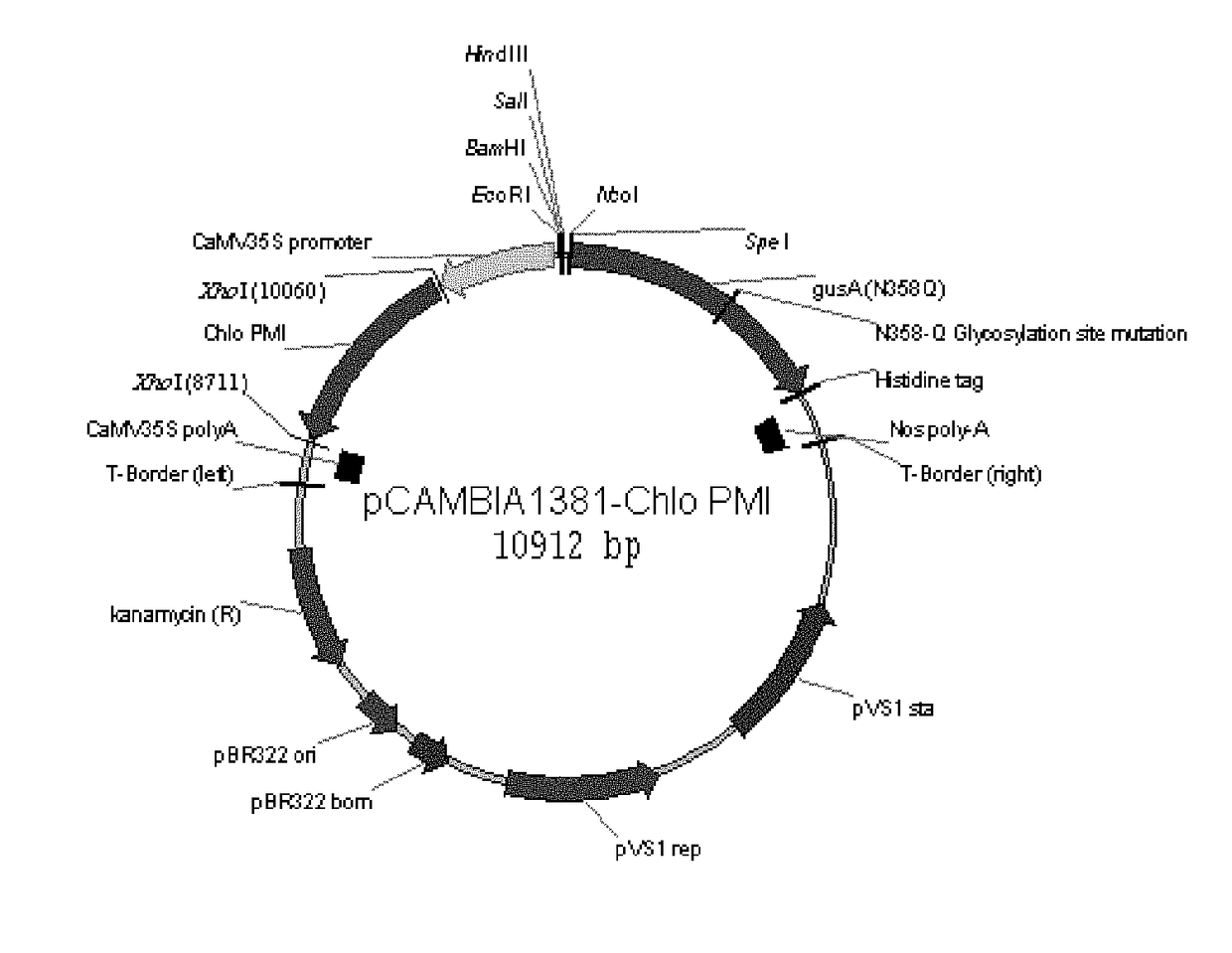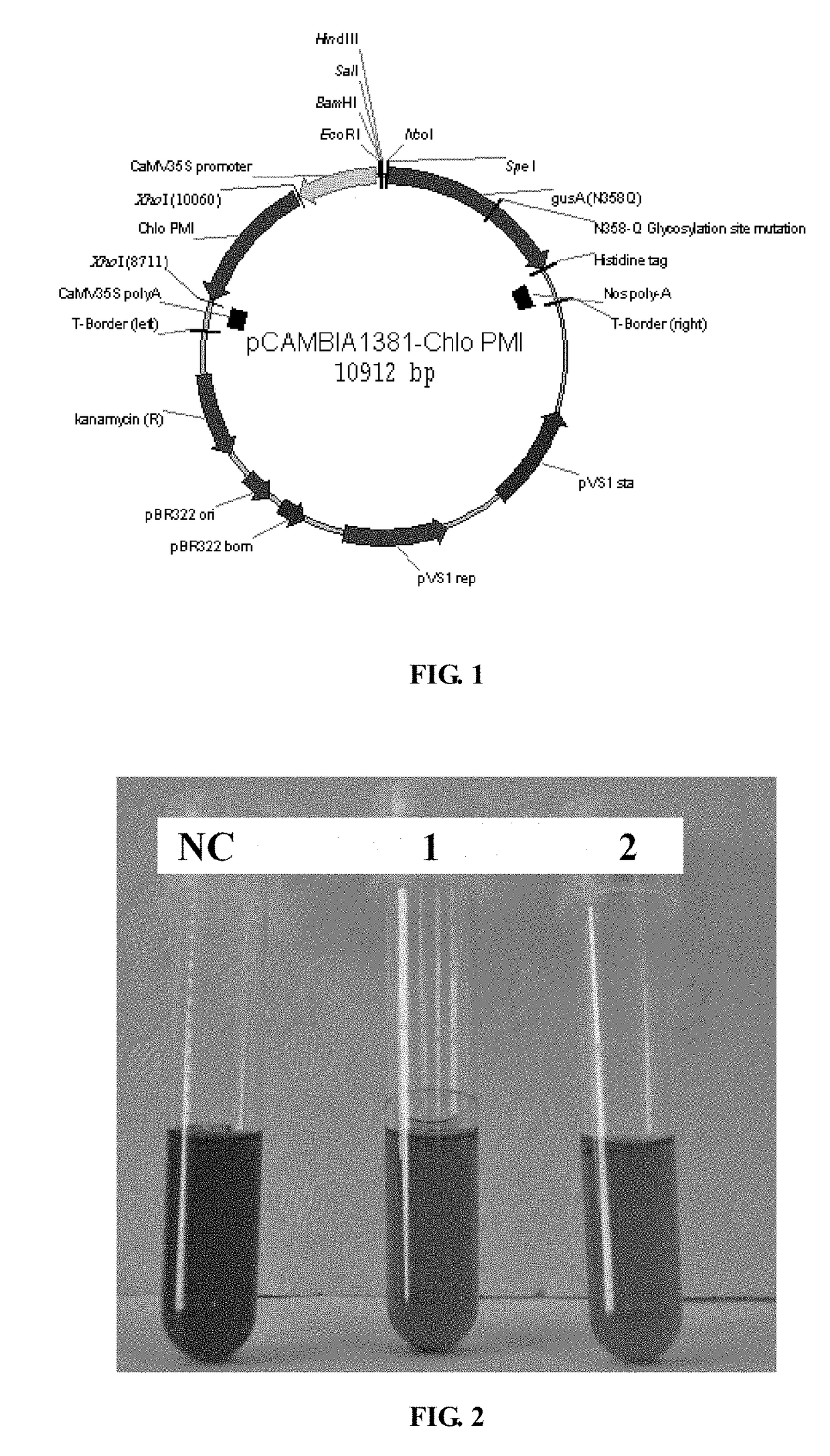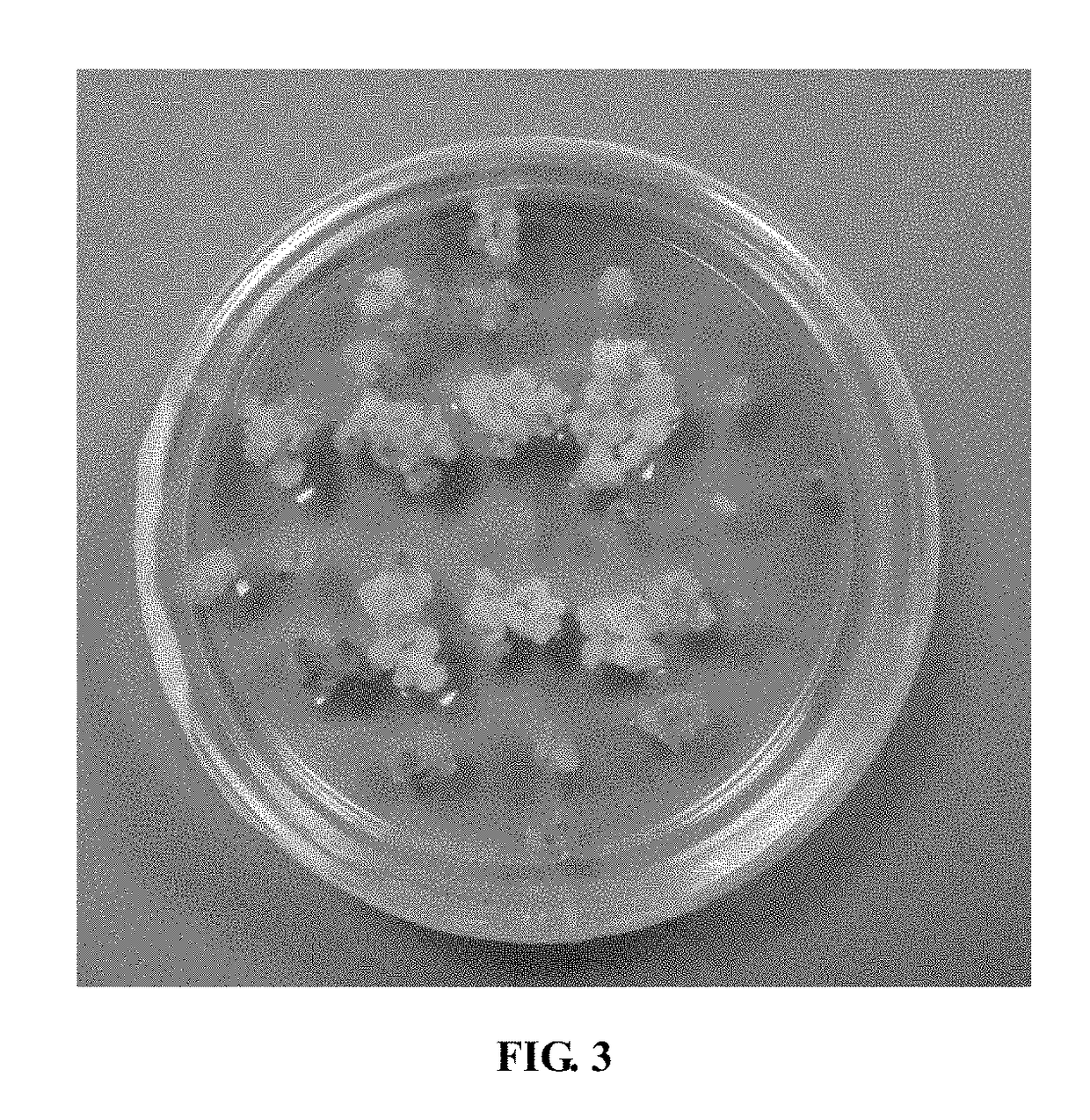Chlorella variabilis-derived phosphomannose isomerase gene and application thereof
a technology of phosphomannose isomerase and chlorella variabilis, applied in the field of biotechnology and plant genetic engineering technology, can solve the problems of adversely affecting the transformation of the recipient genome, the inability of cells to further convert mannose 6-phosphate into fructose 6-phosphate for use in the glycolysis pathway, and the inability to meet large-scale applications, so as to promote and apply transgenic products, eliminating any existing safety doubts
- Summary
- Abstract
- Description
- Claims
- Application Information
AI Technical Summary
Benefits of technology
Problems solved by technology
Method used
Image
Examples
example 1
Obtaining and Cloning a ChloPMI Gene
[0033]A sequence with the highest homology, namely, the ChloPMI protein sequence, was obtained by aligning homologous sequences in the genomic sequence (genome.jgi-psf.org) of Chlorella variabilis which can utilize mannose based on phosphomannose isomerase protein sequence of the bacteria. The phosphomannose isomerase protein sequence of the bacteria is as follows:
MQKLINSVQNYAWGSKTALTELYGMENPSSQPMAELWMGAHPKSSSRVQNAAGDIVSLRDVIESDKSTLLGEAVAKRFGELPFLFKVLCAAQPLSIQVHPNKHNSEIGFAKENAAGIPMDAAERNYKDPNHKPELVFALTPFLAMNAFREFSEIVSLLQPVAGAHPAIAHFLQQPDAERLSELFASLLNMQGEEKSRALAILKSALDSQQGEPWQTIRLISEFYPEDSGLFSPLLLNVVKLNPGEAMFLFAETPHAYLQGVALEVMANSDNLRAGLTPKYIDIPELVANVKFEAKPANQLLTQPVKQGAELDFPIPVDDFAFSLHDLSDKETTISQQSAAILFCVEGDATLWKGSQQLQLKPGESAFIAANESPVTVKGHGRLARVYNKL
[0034]Thereafter, RNA of Chlorella variabilis was further extracted and reverse transcribed into cDNA. According to the coding sequence (CDS) of ChloPMI, gene specific cloning primers, a forward primer 5′...
example 2
Construction of a Prokaryotic Expression Vector Containing the ChloPMI Gene
[0036]PCR amplification was performed by the design of ChloPMI prokaryotic expression primers, a forward primer 5′-GGATCC ATGGCTGGAACGGCGACAGAGA -3′ (underline indicates BamHI restriction site) and a reverse primer 5′-CTCGAGCTCAAAGGCCATTCCGTTG-3′ (underline indicates XhoI restriction site) using the PGEM-T-ChloPMI recombinant plasmid as a template. The prokaryotic expression vector pGEX-ChloPMI fused to GST (glutathione-S-transferase) fragment was then obtained by ligating the recovered PCR-amplified target fragments to pGEX-6P-1 expression vector (available from GE Inc.) digested with BamHI and XhoI, and was transformed into E. coli expressing strain BL21. Simultaneously, a pGEX-6P-1 empty vector and pGEX-PMI containing E. coli phosphomannose isomerase expression vector were also transformed into E. coli expressing strain BL21, respectively.
example 3
ChloPMI Activity Analysis
[0037]The BL21 strain containing the prokaryotic expression vector pGEX-ChloPMI, pGEX-PMI and pGEX-6P-1 empty vector was streaked. Monoclones were picked and inoculated into LB liquid medium (see Table 1 for composition, Agrobacterium culture medium, no agar), and cultured overnight with shaking at 37° C. (200 r / min). On the next day, the culture was centrifuged for 1 min at 6000 r / min at room temperature, the supernatant was discarded and the pellet was resuspended with a small amount of sterilized water. The resuspension was taken and plated on sterilized phenol red chromogenic medium (1% peptone, 0.5% NaCl, 50 mg / L phenol red, 30% mannose, PH 7.4) with 1:50. After 48 h, the change in medium color was observed. If the strain has an ability to metabolize mannose, the medium was acidified, resulting in a drop in PH value. The medium color therefore gradually changed into yellow from red at PH 7.4. Results from activity analysis of different vectors were seen...
PUM
| Property | Measurement | Unit |
|---|---|---|
| time | aaaaa | aaaaa |
| color identification | aaaaa | aaaaa |
| color identification method | aaaaa | aaaaa |
Abstract
Description
Claims
Application Information
 Login to View More
Login to View More - R&D
- Intellectual Property
- Life Sciences
- Materials
- Tech Scout
- Unparalleled Data Quality
- Higher Quality Content
- 60% Fewer Hallucinations
Browse by: Latest US Patents, China's latest patents, Technical Efficacy Thesaurus, Application Domain, Technology Topic, Popular Technical Reports.
© 2025 PatSnap. All rights reserved.Legal|Privacy policy|Modern Slavery Act Transparency Statement|Sitemap|About US| Contact US: help@patsnap.com



